Foire Internationale d’Art Contemporain
Anthony Japour visits the Paris art fair
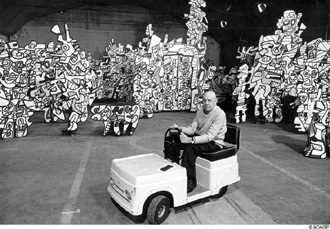

Anthony Japour (AJ) is an art collector, advisor, independent curator, and private art dealer. Japour deals in the international contemporary art movement with a focus on the Chinese Contemporary Art Movement and its relationship to the pillars of Western Contemporary Art. Since 2003, AJ has produced numerous art exhibitions and installations in Miami and South Florida through AJ Japour Gallery and now works on various art projects. AJ has served on the Fine Arts Board and the Cultural Arts Council of the City of Miami Beach.
Celebrating its 40th edition, FIAC, the major contemporary art fair in Paris was superb! I guess competition is a good thing because people vote with their feet. And while the FIAC has been playing second fiddle to London’s Frieze Art Fair for some years, the word on the street was that this year’s FIAC outdid London’s Frieze Art Fair in a very big way. Paris, it seems, perfected the combination of commercial and non-commercial programs for the Fall European art season. FIAC, the commercial art fair is housed in the gorgeous Grand Palais, while Jean Dubbufet was at Les Arts Decoratifs, Zeng Fanzhi at the Musee d”Art Moderne de la Ville de Paris, Zhang Huan at the Petit Palais, Georrg Baselitz at Galerie Thaddaeus Ropac, Roy Lichtenstein at the Centre Pompidou, and Giuseppe Penone at the Chateau de Versailles— in sum a diverse array of incredible modern and contemporary art for collectors, curators, and art students alike.

Jean Dubuffet, Les Arts Decoratifs, Paris
Housed in a museum adjacent to the Louvre, Les Arts Decoratifs in collaboration with the Dubuffet Foundation mounted Jean Dubuffet’s (1901-1985) animated painting, Coucou Bazar originally produced in 1973 for the Solomon R. Guggenheim Museum in New York and re-staged for the Grand Palais in 1978.
Not only did Dubuffet create the artworks, costumes and the sets, he also composed the music. As one of the most important artists of the 20th century, and whose commercial market has been suffering a bit lately, this exhibition is sure to rejuvenate interest in the work of Jean Dubuffet. To say that the work takes your breath away, would be an understatement. As a guest of contemporary collector Nicole Ghez de Castelnuovo from Geneva Switzerland, my colleagues and I were treated to a behind the scenes experience of the Dubuffet work including a tour with the exhibition’s director Sophie Duplaix, the conservator of collections at the Musee National d’Art Moderne at the Centre Pompidou in Paris. While this exhibition ends on December 1, 2013, I would be very surprised if this work did not travel back to this side of the Atlantic where it was first appeared 40 years ago.
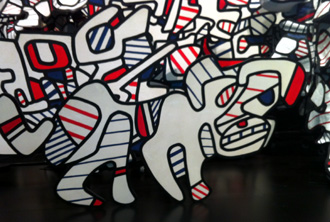
“It is not unlikely that my show will be criticized for placing itself beyond the logic of categories. (…) It is a painter’s work rather that a playwright’s or choreographer’s. Painting is its only parent; and somehow it is itself the animated progeny of painting. Let us imagine a picture which stops being a simple image for contemplation to become a living reality into which we are invited to plunge.”
— Jean Dubuffet
Zeng Fanzhi, Musee d’Art Moderne de la Ville de Paris
Zeng Fanzhi (b. 1964, Wuhan, China) whose work I’m pictured on my art column landing page of SocialMiami.com recently made headlines in the contemporary art world with a record-breaking sale of $23,000,000 at Sotheby’s Hong Kong 40th Anniversary sale; The Last Supper (2001) came from the Belgian collection of Baron and Baroness Guy and Myriam Ullens de Schooten.
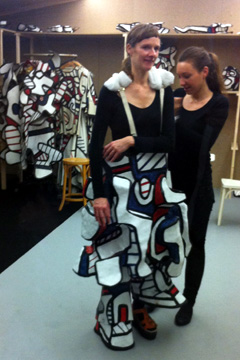
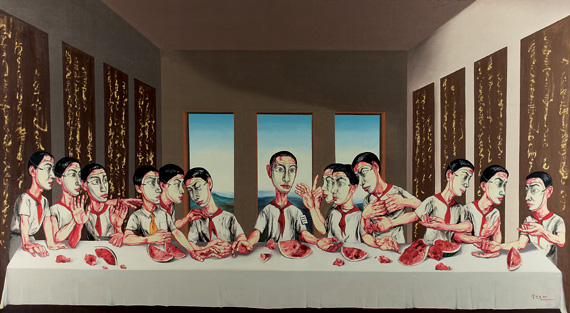
While Leonardo DiVinci’s 15th century mural is considered the original work, the subject of the Last Supper of Christ continues to serve as an inspiration for contemporary artists across the globe.
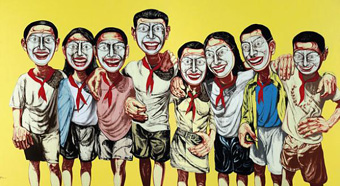
While I was very much aware of Zeng’s exhibition in Paris, I was completely taken by surprise to find that the $23,000,000 painting was also included in the exhibition. The work is part of the artist’s most well-known oeuvre entitled the Mask Series where all of the characters are wearing masks. In China, it is said, one needs to hide emotions behind a mask. Often one sees oversized hands and feet in the painting’s characters. Notably, all of the figures save one in Zeng’s version of The Last Supper are wearing the traditional red scarf of the Young Pioneers symbolizing the blood sacrificed by the revolutionaries of Communist China and is worn in reverence— the exception being the character playing Judas who wears a western-style collared shirt and a typical western-style long tie in yellow. In person, the work has an affecting presence much more so than either in the show’s catalogue or in on-line reproductions.
Georg Baselitz, Galerie Thaddaeus Ropac, Paris
Visiting Galerie Thaddaeus Ropac, the Austrian-born dealer who has France’s biggest commercial contemporary art venue, I came away with the conclusion that increasingly the large and well-funded commercial galleries are becoming very sophisticated museum-like institutions. Georg Baselitz’s (b. 1938, Deutschbaselitz, Germany) exhibition The Dark Side is a case and point. Known as the artist who paints people upside down, the exhibition of monumental sculptures (and paintings) extend his previous sculptural works exclusively with wood to creating bronzes by a very well-established foundry in Berlin. While the sculptures look like sculpted wood, they are in fact bronze burnished in black by the artist.
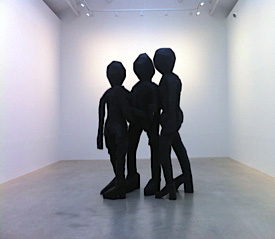
One of the Baselitz sculptures, BDM Gruppe upon first glance immediately evokes The Three Graces; in fact, the work is a memory of three parading girls walking arm in arm in the artist’s hometown of Deutschbaselitz (he later renamed himself after the city). BDM, the Bund Deutscher Madel (League of German Girls), was the girls’ branch of the Hitler-Jugend, the youth organization that played an important role in Nazi Germany. As a young boy at the age of six, the artist recalls seeing the girls singing the praises of Adolph Hitler. Now seventy years later, this memory resurfaces in this sculpture. The girls are arm in arm, but as the artist and critic and art historian John-Paul Stonard state, “they appear ungainly . . . with large heavy heads . . .balancing on awkward bodies . . . on oversized clumsy high-healed shoes”. Using the harshness of the carved wood, now in bronze, the artist is portraying a kind of opposite of the Three Graces by Antonio Canova (1757-1822) made of smooth white marble. Strong and not easy, but this is contemporary art.
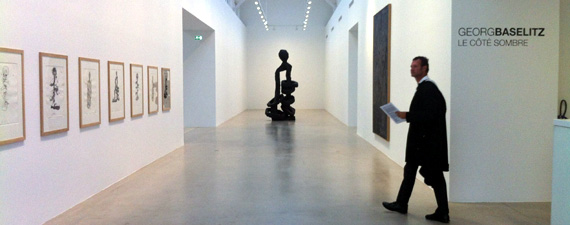
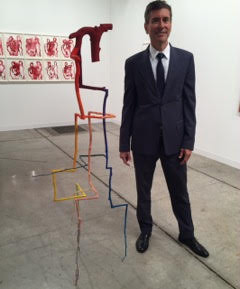
Anthony Japour is an art collector and art advisor. Japour lectures on the Chinese Contemporary Art Movement and its relationship to the pillars of Western Contemporary Art. For over a decade [2002-2012], Japour mounted numerous art exhibitions and installations in Miami Beach and South Florida through AJ Japour Gallery and linked these exhibitions to charity events at his home in South Beach devoted to the health, education and welfare of children. Japour has served on the Fine Arts Board and the Cultural Arts Council of the City of Miami Beach. Japour has been a contributor writing on contemporary art for SocialMiami.com since 2010.


